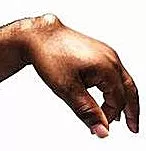
Ganglion Cyst
Ganglion cysts are noncancerous lumps that usually develop in the wrist or hands. They’re typically round or oval and are filled with a jelly-like fluid. These cysts also may occur in the ankles and feet.
If your child needs surgery or casting, our Fracture Care Clinic opens every day and you do not need an appointment. Surgery rooms get scheduled every morning, so your child receives the care and attention they need right away.
Ganglion Cyst
A ganglion cyst refers to a mass that contains fluid and can develop close to tendons or joints. It’s not cancer, either. The wrists or hands are the most typical locations. Although normally harmless, the bumps may appear as strange and lumpy. Many times, the bumps will go away without any treatment. Our doctors can remove a ganglion cyst with a small and quick procedure.
The Definition of a Ganglion Cyst
 A ganglion refers to a tiny bulge found under the skin that is filled with a thick, jelly-like substance. It appears and feels like a smooth mass. While occasionally they appear after an injury, the majority of the time doctors do not have an explanation. The fluid inside a ganglion, which typically links to a joint or tendon, appears thicker than the fluid that “lubricates” the sheaths of the joint and tendon (synovial fluid). The cysts normally appear on the back of the wrist, but these bumps may appear on the top of the foot, and the hand. Less frequently, other bodily locations are impacted. Cysts may feel spongy or hard, depending on their size. Cysts can grow into one huge cyst or several smaller ones.
A ganglion refers to a tiny bulge found under the skin that is filled with a thick, jelly-like substance. It appears and feels like a smooth mass. While occasionally they appear after an injury, the majority of the time doctors do not have an explanation. The fluid inside a ganglion, which typically links to a joint or tendon, appears thicker than the fluid that “lubricates” the sheaths of the joint and tendon (synovial fluid). The cysts normally appear on the back of the wrist, but these bumps may appear on the top of the foot, and the hand. Less frequently, other bodily locations are impacted. Cysts may feel spongy or hard, depending on their size. Cysts can grow into one huge cyst or several smaller ones.
Although several tiny cysts may appear as one large cyst, they are typically connected by a common stalk seen in the deeper tissue. About half of all soft-tissue tumors of the hand are of this kind and not hazardous. ganglion cysts, also known as Bible cysts, affect adults between the ages of 20 and 40, and three times more frequent in women than in males. Ganglion cysts can develop in kids under the age of 10.
Signs and Symptoms
It’s possible that a ganglion cyst will hurt. The cysts can appear soft or quite hard and appear oval or circular.
How Do Ganglion Cysts Appear?
The following are the traits of a ganglion cyst:
Location
- They mostly grow in the tendons and joints that surround them.
- Typically, they affect the hands or wrists.
- Ganglion cysts will also affect the ankles and feet.
- The cysts are also observed next to other joints.
Size and Shape
- They have an oval or circular form.
- Smaller than 2.5 cm in diameter.
- Some cysts appear so small that they cannot be felt
- When your child uses the joint repeatedly, the cyst may grow in size.
QUESTIONS AND ANSWERS
What causes ganglion cysts in children?
Ganglion cysts are generally caused by the leakage of synovial fluid from a joint or tendon sheath, which then accumulates and forms a cyst. Doctors do not know the exact cause of ganglion cysts but they may develop due to:
- Repetitive Trauma: In some cases, repeated minor injuries or stress to a joint or tendon may contribute to the formation of a ganglion cyst.
- Joint or Tendon Irritation: Irritation or inflammation of a joint or tendon can lead to the production of excess synovial fluid, which can then accumulate and form a cyst.
- Idiopathic (Unknown) Causes: In many cases, the exact cause of a ganglion cyst remains unknown.
Are ganglion cysts in children painful, and how are they diagnosed?
Ganglion cysts can vary in terms of pain. Some children may experience pain and discomfort, while others may have no symptoms at all. Diagnosis typically involves the following:
- Physical Examination: A healthcare provider will perform a physical examination of the cyst, assessing its size, location, and any associated pain or discomfort.
- Imaging Studies: Sometimes, doctors may use an ultrasound or MRI to confirm the diagnosis and rule out other potential causes of the lump.
- Aspiration: In some cases, a doctor may use a needle to aspirate (remove) the fluid from the cyst for analysis. This can also provide temporary relief from symptoms.
How do doctors treat ganglion cysts in children?
Treatment for ganglion cysts in children depends on several factors, including the size, location, and whether the cyst is causing symptoms. Common treatment options include:
- Observation: If the ganglion cyst appears small, painless, and does not cause functional limitations, a healthcare provider may recommend simply monitoring it over time. Some cysts may resolve on their own.
- Aspiration: If the cyst causes pain or discomfort, a doctor may aspirate the cyst with a needle to remove the fluid. However, this may not always prevent the cyst from returning.
- Surgery: In cases where the cyst appears large, painful, or causes functional impairment, doctors may recommend surgical removal. Surgery typically involves removing both the cyst and a portion of the joint capsule or tendon sheath to reduce the risk of recurrence.

The doctors at Medical City Children’s Orthopedics and Spine Specialists treat children with Ganglion Cysts.
The lump will first get examined by one of our doctors. They’ll enquire about your child’s health and the duration of the bump. You’ll get questioned about your child’s symptoms as well. If they cannot detect the lump, they may arrange imaging tests like an X-ray, ultrasound, or MRI to distinguish between solid tumors and those filled with liquid, like a ganglion cyst. Additionally, if the cyst appears filled with a fluid, the doctor will draw a sample of the cyst’s fluid for analysis.
Who Gets Ganglion Cysts?
Everyone can develop ganglion cysts, according to what the medical profession now knows about them. Your child can develop one of these cysts if certain conditions exist:
- Ganglia appear three times more frequently in girls than in boys.
- The majority of the time, cysts appear between the ages of 20 and 40. They appear frequently in children but often resolve within one year.
- Previous injury: Some medical professionals think that a joint injury might eventually lead to the development of a ganglion cyst. This notion has not yet been validated by research.
Common Methods of Ganglion Cyst Therapy
Although it may take some time, a ganglion cyst frequently resolves on its own, especially in young children. If the cyst does not go away by itself, treatment for ganglion pain and stiffness relief include:
- Range of motion exercises
- Over-the-counter painkillers
- Wearing a wrist splint
If none of these are effective, your doctor could recommend aspiration which removes fluid from the ganglion cyst quickly and painlessly. In some circumstances, the doctor may inject a steroid to lessen the likelihood that the ganglion cyst will recur; however, this will not definitely stop the re-accurrence. Following your child’s treatment, the doctor will bandage the area where the fluid was drained. Doctors will perform an aspiration as an outpatient procedure in the clinic setting, so you and your child can leave as soon as the doctor finishes. As it is less intrusive, it is frequently suggested as a first alternative before any surgical procedures. Parents should know that aspiration-treated ganglion cysts recur in 50% of cases.
Your physician could suggest surgery if your child’s ganglion cyst reappears. When the doctor surgically removes your child’s ganglion cyst, the procedure takes place under general anesthetic.
Surgery
In order to remove your child’s cyst, your surgeon will make a small incision across the area of the cyst. The surgeon will complete the procedure by closing the incision with absorbable stitches and a bandage. A bandage will cover the wound for 1-2 weeks following the surgery. To choose the best course of action, our doctor will go over your treatment choices with you.
Exactly how are Ganglion Cysts Handled?
The following treatments are available for ganglion cysts:
- Observation: a large majority of ganglion cysts in children will resolve within one year.
- Anti-inflammatory drugs may reduce swelling, reducing minor pain.
- Splints or braces provide support and prevent your child from moving the injured region, which reduces discomfort and swelling.
- Your doctor may aspirate the cyst by using a needle to extract fluid from the cyst. Typically, doctors conduct this procedure in their offices.
- Your child’s symptoms might recur since this therapy just eliminates the fluid from the cyst and not the entire cyst.
When Does a Ganglion Cyst Need Surgery?
In the event that previous therapies fail to remove your child’s cyst or it returns, your doctor may recommend surgery. Surgeons treat Ganglia by removing the whole cyst by surgery. A stalk-like structure (root) is frequently seen with a cyst. Your doctor will perform the procedure through a small incision. To properly fix the condition, surgeons may need to remove some tissue from the adjacent joint. Ganglionectomy refers to the medical term for surgery to remove a ganglion cyst. Typically, it is an outpatient operation. Complete recovery and healing take two to six weeks, but ganglia recur in 5 to 15% of patients.
Home Remedies:
- If your child has a ganglion cyst in his or her foot, they should wear soft or open shoes to reduce friction.
- Ibuprofen-type medications might help with pain.
Old passed-down remedies involve beating Ganglion Cysts with a book or other hard items. However, others claim that this approach does not work and to avoid striking the cyst as doing so might harm adjacent tissues including joints, tendons, or tendon sheaths. Because it can get infected, patients should avoid popping the cyst. A ganglion cyst normally does not cause substantial consequences and in most cases does not pose a serious medical condition. However, it is advisable to see an orthopedic doctor if it is uncomfortable or restricting a range of motion. Finally, patients should know that removing a ganglion cyst by surgery will create a scar and know that the cyst can return.
Why Choose Medical City Children’s Orthopedics and Spine Specialists
The very first reason to choose Medical City Children’s Orthopedics and Spine Specialists for your child is because we are experts in children’s health. In as much as there is a big difference between a Cervical Sprain and a Strain, parents should want their child treated for the exact cause and we can deliver that treatment. We do it all the time in our Arlington, Dallas, Flower Mound, Frisco, and McKinney, TX offices. To obtain the very best diagnosis and treatment, we invite parents to give us a call to make an appointment for any pain being experienced by their child. In conclusion, as pediatric orthopedic doctors, we are experts with children and ganglion cysts. For the best care and or second opinions, please call for an appointment.
____________________
Footnote:
Call 214-556-0590 to make an appointment.
Comprehensive services for children from birth through adolescence at five convenient locations: Arlington, Dallas, Flower Mound, Frisco and McKinney.
